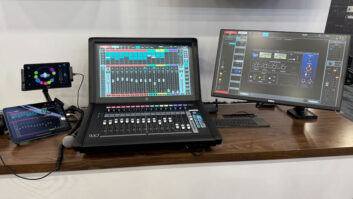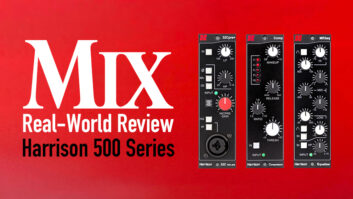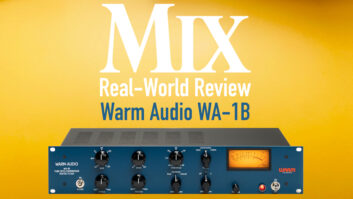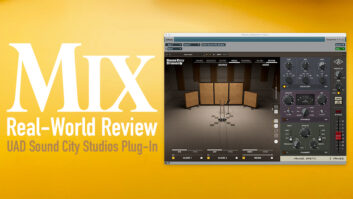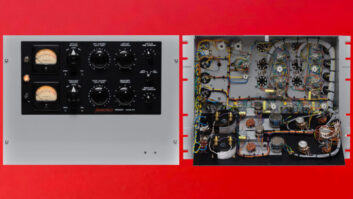Signal chain processing resides inside the box more than ever, and alongside a DAW, plug-ins, control software, and various routing and data delivery tools. But the 20 hardware units listed below have been effectively deemed irreplaceable, as manufacturers continue to build these world-class products as well as introduce some very cool new designs to the marketplace. This product category provides equalization, compression/limiting, filtering, and effects processes to those who want to touch the knobs and feel the heat during the rituals of recording, mixing and mastering audio content.

Featuring the iconic 3-band EQ of the timeless Neve 1073 module, AMS-Neve 1073 SPX is a mic preamp/EQ 1U rackmount product with high-pass filter and is notable for its extra functions, including integrated DI input and selectable insert, as well as phantom power, output level control, and optional digital I/O module for AES and FireWire connectivity.
An imprint of BAE Audio now offers its own 1173-style mic pre and compressor, which is the product debut for UK Sound, a subsidiary of BAE. Built in California, the UK Sound 1173 is the result of a design collaboration among Los Angeles-based producer Warren Huart, gear designer Michael Stucker and UK Sound. The unit features the beloved 1073 preamp circuit and a studio FET compressor at a reportedly affordable price, and offers input and output gain and compression ratios of 4:1, 8:1, 12:1, and 20:1.
Designed by former Lexicon personnel, the Bricasti Model 7 (M7) stereo digital reverb processor delivers realistic, lush and adjustable acoustic environments. Built within a rigid 1U chassis, the unit includes 100 factory presets and 100 user registers with Favorites, accessible by the unit’s front panel or optional M10 Remote Console. Its presets use three independently adjustable reverb engines: The first covers early reflections, the second covers late decay tail, and the third handles early reverberation below 80 Hz. Bricasti also offers the M7M, a plain-front paneled version of the Model 7.
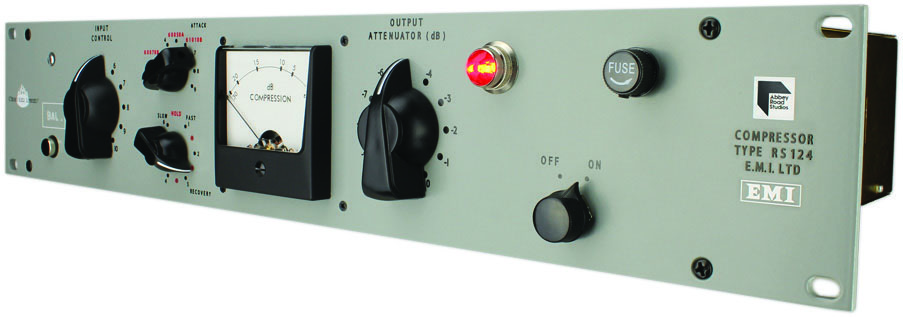
The Chandler Limited RS124 Compressor is a re-creation of the legendary EMI/Abbey Road RS124, designed in 1960 by Abbey Road Head of Technical Bill Livy, Deputy Head Len Page and EMI Audio Designer Mike Bachelor. Most closely associated with recordings made by The Beatles at Abbey Road Studios, the RS124 was used in many applications, from tracking to bus compression, mixing and mastering. All these years later, Chandler Limited’s RS124 Compressor is designed based on Abbey Road Studios’ favorite historic RS124s—serial numbers 60070B, 60050A, and 61010B, explains the company. Features include input control, output attenuation, Recovery (release) control and the unique “HOLD” setting, as well as adjustable attack and selectable output impedance, among others.

Upon its debut in late 2010, Dangerous Music’s BAX EQ—inspired by P.J. Baxandall’s shelving filter topologies—was the buzz of the spring. It allows tone shaping, or equalization, via one potentiometer without the need for a switch to select boost or cut, just like the most popular hi-fi preamps of the past half-century. NYC-based mastering engineer Alan Silverman, in reviewing the unit, called it “a delicious desert with no calories… The design has characteristics that make it especially suitable for musical tone shaping—extremely smooth, flat shelves and minimal phase shift. The filter components reside in the feedback loop, leaving the main signal path pure. Dangerous Music’s lead designer, Chris Muth, has skillfully exploited these advantages to create an exceptional mastering-grade, analog stereo EQ.”

Arguably, there is no compressor sound that is as famous and as ubiquitous as that of the dbx Professional 160 Series, first launched in the mid-’70s. Today, the 160XT compressor/limiter remains in dbx’s lineup for good reason. Key features include its switch-selectable OverEasy and Hard Knee compression curves, and unique INFINITY + inverse-compression mode. Best of all, a new 160XT lists for approximately $429—not bad to inject a proven classic into your rack.
There’s compression, and then there’s “distression.” I distinctly recall, arriving as a newbie intern at NRG Recording Services in late-’90s North Hollywood, that there was no hotter outboard processor than Empirical Labs’ Distressor. Today, it remains a key part of the sound of rock ’n’ roll, thanks to Dave Derr’s initial inspiration from well-tweaked 1176s, LA-2As and the like. The Distressor is currently available in four configurations: the original EL8, the modified EL8-X with two additional functions (British Mode and Image Link), the stereo EL8-S (actually a pair of factory-matched Distressors), and the stereo EL8X-S (also with British Mode and Image Link).
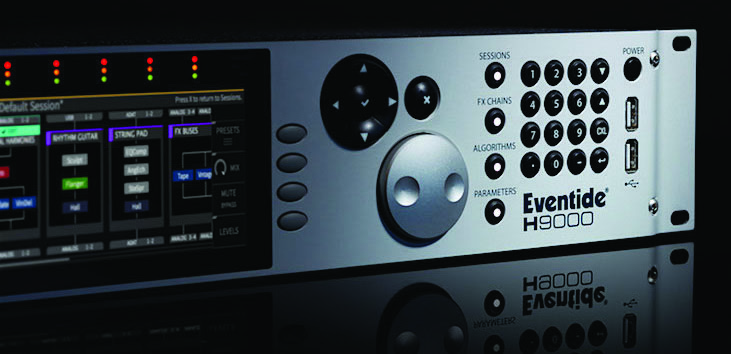
The Eventide H9000—a new network-ready, multichannel rackmount audio effects processing unit—reportedly features eight times the processing power of the H8000, with four quad-core ARM processors serving as 16 DSP engines; eight channels of analog, AES/EBU and ADAT channels; 16 USB audio channels; and optional I/O including MADI, Dante, Ravenna, and more. The H9000 also introduces Eventide’s FX Chains concept, allowing users to connect any set of four effects with flexible routing. The H9000’s remote control application, called emote, is available for DAW users or for audio network-based applications.
While Focusrite has emerged as a leading force in the proliferation of AoIP-ready front-end I/O and processing, the company flagship ISA line endures with the premium ISA 430 MkII, a lovely channel strip featuring the original ISA 110 microphone preamplifier and ISA 130 dynamics section with VCA/optical compressor/limiter and gate, the latter of which was originally designed by Rupert Neve for Sir George Martin’s Neve console. Other features include filters, parametric EQ, shelving EQ, de-esser and optional stereo A/D card.

Madrid, Italy’s Heritage Audio Elite Series is a new line of analog processors characterized by the company as “more affordable.” The Elite Series features Carnhill transformers, hand-wound in St. Ives, England. Made to the same specifications as Heritage’s 73JR, 73EQJR and DMA73 models, the HA-73 EQ Elite offers features such as a fully discrete 3-band classic equalizer with vintage correct inductors; high shelf at 12 kHz; midband selectable between six different frequencies; low shelf selectable between four different frequencies; inductor-based highpass filter, and more.
Lexicon, the go-to source for fine reverbs for decades, rolled the attributes of the PCM81 and PCM91 effects units into its PCM92, which offers 28 mono and stereo reverbs, delays and modulations with useful routing features centered on 1,200-plus presets incorporating time-proven classic patches from the Lexicon library. The company states that its Hall, Concert Hall and Random Hall algorithms have been used on “more than 80 percent of all recorded music.” Other features include multivoice pitch shift, HiQnet System Architect compatibility, foot-controlled preset/parameter adjustment for live sound use, and much more.

A smash hit with proven components gleaned from previous legendary products like the VoxBox (tube preamplifier section and ELOP compressor) and SLAM! (DI section), Manley Labs’ CORE channel strip also offers a Baxandall-style EQ and a limiter on its output. Best of all, it’s nearly $2k less than the lauded VoxBox that inspired its development, but is reportedly just as flavorful.
Designed by Leif Masses, Maselec’s MEA2 stereo EQ continues to be a mainstay in professional mastering circles. It is a 4-band, dual-mono unit with completely independent left and right channels. Each band comprises 21 frequencies, 21 steps of boost/cut ranging from ±.5 dB to 8 dB, and six settings for Q or bandwidth. Meanwhile, its Master Series sibling, the Maselec MLA2 compressor, is inspired by “old school” models while peppered with modern refinements. Both are of world-class quality and revered by many.
Though not hardware, Millennia Media’s new HV-3R AELogic Remote Control Software is an essential digital tool designed for pairing with the company’s HV-3R operable over Wi-Fi, using a high-resolution Android tablet client with Microsoft Remote Desktop. Meanwhile, Millennia still ships many of its world-class EQ, compression and multiparameter analog processors, including the NSEQ-2 Twin-Topology 2-channel parameteric EQ, NSEQ-4 solid state 2-channel parametric EQ, TCL-2 Twin Topology 2-channel compressor/limiter, and the STT-Origin, Millennia’s flagship channel strip featuring preamp, compressor/limiter and EQ.

The lovely Portico II channel strip from Rupert Neve Designs is packed with 4-band EQ, compressor/limiter, highpass filter, de-esser, the “Silk” texture feature, and more. It is a true standout, even in RND’s entirely top-shelf collection of analog processors. Years ago, while coordinating the Portico II’s full review with engineer Rob Tavaglione, he shared this: “It’s hard not to love it. The EQ in general, the de-esser, the superb compressor and the Silk features will surprise [its users] and demand daily usage.”

Though Solid State Logic’s individual analog processor offerings are now largely available as 500 Series or as proprietary X-Rack based modular units, the company continues to build what is arguably the world’s most popular, famous and beloved master bus compressor into a 1U rack, the G Series Stereo Bus Compressor. Features include a gain reduction meter, just like the one in the original SSL G Series console, external sidechain source select, auto fade with rate control automatic linear fade in/out control, and a remote connector for remote operation of the auto fade function. It sounds golden, perhaps platinum.
SPL’s venerable Transient Designer, available in 2- and 4-channel versions, remains an invaluable tool to shape the dynamic response of any signal—notably useful on percussive sound sources, acoustic guitars and pianos. In use, it processes dynamic characteristics, emphasizing or smoothing attack and/or extending or shortening sustain times. Its processing is not dictated by signal level, so all material is processed equally, whether loud, soft or somewhere in between. With its simple two-knob user interface per channel—attack and sustain adjustments—the Transient Designer is the tweak-happy kind of outboard processor that you just have to use to understand its appeal.
TC Electronic’s Finalizer 96K offers easily applied mastering and multiband compression tools that I would describe as “magic” on most modern pop mixes. Though it doesn’t replace a good mastering engineer, it allows many access to some incredibly valuable tools. Features include 5-band, 24-bit stereo digital EQ for signal shaping; dynamic EQ, stereo adjust, Lexicon’s Digital Radiance Generator, and spectral stereo image enhancements; real-time Gain Maximizer for normalization; variable slope multiband expander; multiband compression; multiband variable ceiling limiter; a manual or auto-fade tool; and more.
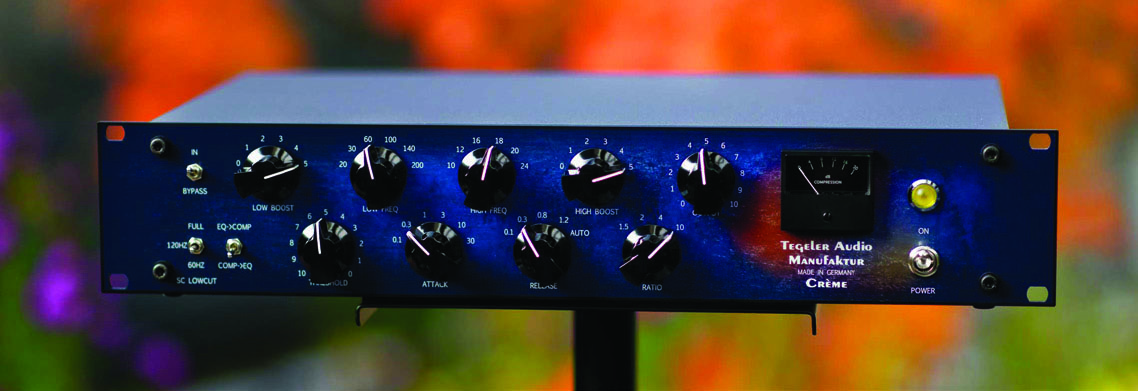
Tegeler Audio Manufaktur of Berlin, Germany is now shipping its Crème—a passive EQ based on the legendary Pultec plus a bus compressor—in North America. The brand was first recognized on the pro audio scene with its Schwerkraftmaschine, a plug-in controllable stereo analog vari-tube compressor featuring variable sidechain that works as a low-cut, tilt EQ, and a mixer to blend compressed and uncompressed signals, as well as transformer-balanced inputs and outputs.
Touted as serious yet seriously affordable gear, Warm Audio offers some classically inspired analog processing that is so lovable due to attractive pricing and fine performances. First, Warm’s EQP-WA is a Pultec-style tube EQ featuring USA-made CineMag transformers and Tung Sol tubes, while the WA76 Limiting Amplifier and WA2A Tube Opto-compressor are inspired by the 1176 and LA2A, respectively. MSRP is way below $1k for any one of these units.
